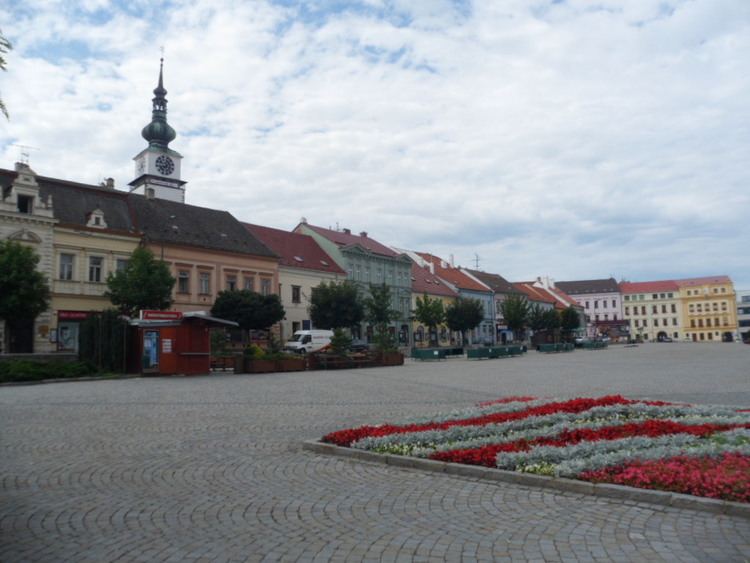- summer (DST) CEST (UTC+2) Local time Tuesday 12:54 AM | Elevation 405 m | |
 | ||
Weather 4°C, Wind NW at 6 km/h, 63% Humidity Points of interest St Procopius Basilica i, Malovaný dům, Muzeum Vysočiny Třebíč, Třebíč, Městská věž | ||
Třebíč ( [ˈtr̝̊ɛbiːtʃ]; German: Trebitz) is a town in the Moravian part of the Vysočina Region of the Czech Republic.
Contents
- Map of 674 01 TC599ebC3ADC48D Czechia
- History and sights
- History in dates
- Town districts
- Transit
- Festivals
- People
- Schools
- Partnership towns
- References
Map of 674 01 T%C5%99eb%C3%AD%C4%8D, Czechia
Třebíč is situated 35 km southeast of Jihlava and 65 km west of Brno on the Jihlava River. Třebíč's elevation is from 392 to 503 metres above sea-level.
Třebíč has a temperate climate with occasional rains. Average annual temperature is 7.5 °C, average temperature in July is 18.5 °C and −3.4 °C in January.
Třebíč is a regional centre with a population of approximately 40,000. In the age of expansion, Třebíč was the third most important town in Moravia. The population growth started after World War II. Třebíč is the administrative capital of the Třebíč District.
There are many well-known tourist sights. The Jewish Quarter and St. Procopius Basilica are listed as a UNESCO World Heritage Site.
Nearly 37 thousand people lived in Třebíč in 2016. Beginning of the town's history is connected with an establishment of Benedictine monastery, where the castle is located today.
History and sights
The historical treasury of Třebíč includes the old Jewish Quarter and the large Romanesque St Procopius' Basilica, which incorporates some later Gothic features, including a rare example of a ten-part (also known as 'botanical') rose window. Such designs reflect the five or ten parts of the roseaceae family flowers and fruit, based on their five sepals and petals or the usual ten segments of their fruit. Botanical rose windows contrast with more complex Gothic windows that contain more segments (usually multiples of traditional gothic units of design – three trefoil, or four quatrefoil). Another thesis says that these decorations are based on an ancient design, inspired by forerunners in the wheel of life, associated with eastern religions nowadays, or may allude to the Virgin Mary.
The famous Basilica originated in the early 12th century as a Benedictine monastery. It was endowed so well, that it led to the establishment of a local commercial centre; the town of Trebic. The monastery was rebuilt during the reign of King Wenceslas I (1230–53), and again at the end of the fifteenth century. During the first half of the 16th century some of Trebic's historic monastic buildings were remodeled into a castle, and were later renovated in Baroque style.
In the early eighteenth century changes were introduced on the basilica by Czech architect, Frantisek Maxmilian Kanka; windows were enlarged, buttresses were added, a south-west tower was rebuilt, and a new west front with two towers was constructed in a gothic baroque style.
The historical town of Trebic, which extends on both sides of the river Jihlava, was declared a Conservation Area in 1990. The Jewish Quarter and St. Procopius Basilica together with the castle and gardens, are all included within the Trebic Conservation Area.
History in dates
Town districts
Transit
Important trade routes, that had been leading near Třebíč already in ancient times were called: Habry Route, Lovětín Route and Libice Route.
Nowadays, Třebíč is an important traffic junction of the region. The main roads crrossing Třebíč are I/23 (Brno – České Budějovice) and II/360, which connects Třebíč with the highway D1. Road II/405, passing near the town, connects Třebíč with the capital city of Vysočina Region – Jihlava.
The railway has the east-west direction in Třebíč. This railway No. 240 connects Třebíč with cities of Brno and Jihlava. There are two train stations serving the town: Třebíč and Třebíč-Borovina.
There is the small sport airport in the outskirts.
The trolley was projected in the history in Třebíč but has never been realized.
In Třebíč there are several segregated cycle facilities, including a bike route leading from Jihlava to Raabs an der Thaya, which was built in 2009.
